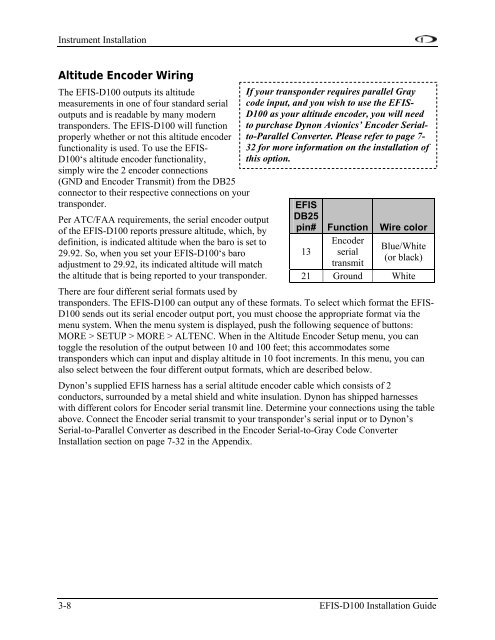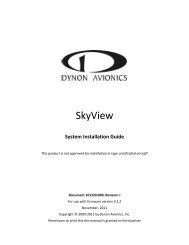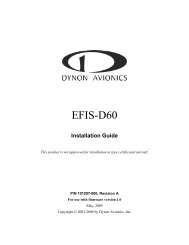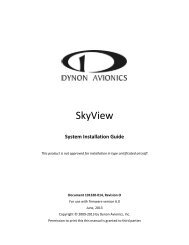EFIS-D100 Installation Guide - Dynon Avionics
EFIS-D100 Installation Guide - Dynon Avionics
EFIS-D100 Installation Guide - Dynon Avionics
You also want an ePaper? Increase the reach of your titles
YUMPU automatically turns print PDFs into web optimized ePapers that Google loves.
Instrument <strong>Installation</strong><br />
Altitude Encoder Wiring<br />
The <strong>EFIS</strong>-<strong>D100</strong> outputs its altitude<br />
measurements in one of four standard serial<br />
outputs and is readable by many modern<br />
transponders. The <strong>EFIS</strong>-<strong>D100</strong> will function<br />
properly whether or not this altitude encoder<br />
functionality is used. To use the <strong>EFIS</strong>-<br />
<strong>D100</strong>‘s altitude encoder functionality,<br />
simply wire the 2 encoder connections<br />
(GND and Encoder Transmit) from the DB25<br />
connector to their respective connections on your<br />
transponder.<br />
Per ATC/FAA requirements, the serial encoder output<br />
of the <strong>EFIS</strong>-<strong>D100</strong> reports pressure altitude, which, by<br />
definition, is indicated altitude when the baro is set to<br />
29.92. So, when you set your <strong>EFIS</strong>-<strong>D100</strong>‘s baro<br />
adjustment to 29.92, its indicated altitude will match<br />
the altitude that is being reported to your transponder.<br />
If your transponder requires parallel Gray<br />
code input, and you wish to use the <strong>EFIS</strong>-<br />
<strong>D100</strong> as your altitude encoder, you will need<br />
to purchase <strong>Dynon</strong> <strong>Avionics</strong>’ Encoder Serialto-Parallel<br />
Converter. Please refer to page 7-<br />
32 for more information on the installation of<br />
this option.<br />
<strong>EFIS</strong><br />
DB25<br />
pin# Function Wire color<br />
13<br />
Encoder<br />
serial<br />
transmit<br />
Blue/White<br />
(or black)<br />
21 Ground White<br />
There are four different serial formats used by<br />
transponders. The <strong>EFIS</strong>-<strong>D100</strong> can output any of these formats. To select which format the <strong>EFIS</strong>-<br />
<strong>D100</strong> sends out its serial encoder output port, you must choose the appropriate format via the<br />
menu system. When the menu system is displayed, push the following sequence of buttons:<br />
MORE > SETUP > MORE > ALTENC. When in the Altitude Encoder Setup menu, you can<br />
toggle the resolution of the output between 10 and 100 feet; this accommodates some<br />
transponders which can input and display altitude in 10 foot increments. In this menu, you can<br />
also select between the four different output formats, which are described below.<br />
<strong>Dynon</strong>’s supplied <strong>EFIS</strong> harness has a serial altitude encoder cable which consists of 2<br />
conductors, surrounded by a metal shield and white insulation. <strong>Dynon</strong> has shipped harnesses<br />
with different colors for Encoder serial transmit line. Determine your connections using the table<br />
above. Connect the Encoder serial transmit to your transponder’s serial input or to <strong>Dynon</strong>’s<br />
Serial-to-Parallel Converter as described in the Encoder Serial-to-Gray Code Converter<br />
<strong>Installation</strong> section on page 7-32 in the Appendix.<br />
3-8 <strong>EFIS</strong>-<strong>D100</strong> <strong>Installation</strong> <strong>Guide</strong>
















